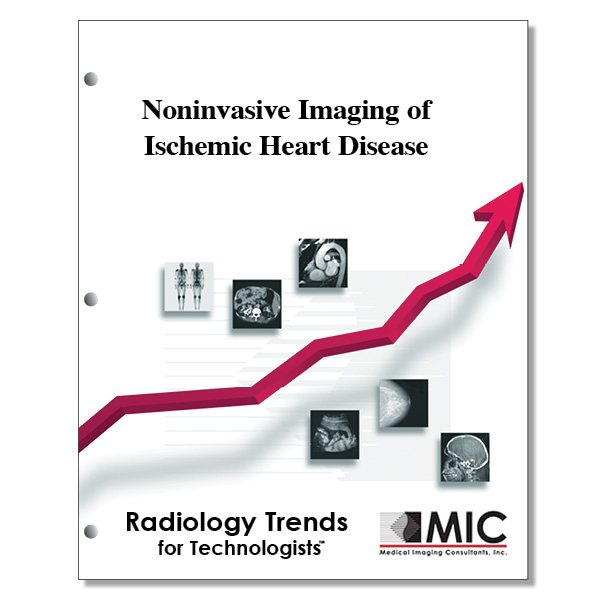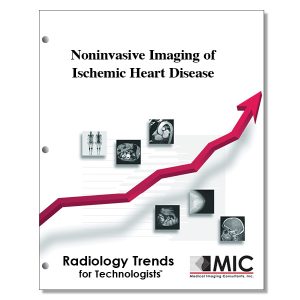

Noninvasive Imaging of Ischemic Heart Disease
A presentation of imaging findings of ischemic heart disease, highlighting the advantages and disadvantages of the various noninvasive imaging methods used to assess the condition.
Course ID: Q00668 Category: Radiology Trends for Technologists Modalities: Cardiac Interventional, CT, MRI, Nuclear Cardiology, Nuclear Medicine, PET, Sonography5.0 |
Satisfaction Guarantee |
$39.00
- Targeted CE
- Outline
- Objectives
Targeted CE per ARRT’s Discipline, Category, and Subcategory classification:
[Note: Discipline-specific Targeted CE credits may be less than the total Category A credits approved for this course.]
Computed Tomography: 2.50
Procedures: 2.50
Neck and Chest: 2.50
Nuclear Medicine Technology: 2.50
Procedures: 2.50
Cardiac Procedures: 2.50
Registered Radiologist Assistant: 4.00
Procedures: 4.00
Thoracic Section: 4.00
Outline
- Introduction
- Pathophysiology of Ischemic Heart Disease
- Noninvasive Anatomic Assessment of Coronary Artery Stenosis
- Noninvasive Functional Assessment of Coronary Artery Stenosis
- Cardiac MR Stress Perfusion Imaging
- Dual-Bolus Method
- Dual-Sequence Method
- CT Stress Perfusion Imaging
- Static CT Stress Perfusion
- Dynamic CT Stress Perfusion
- Fractional Flow Reserve CT
- PET Myocardial Perfusion Imaging
- SPECT Myocardial Perfusion Imaging
- Stress Echocardiography
- Cardiac MR Stress Perfusion Imaging
- Comparison of Noninvasive Imaging Modalities to Assess Physiologic Significance of Coronary Artery Stenosis
- Myocardial Infarction
- Cardiac MRI
- Computed Tomography
- PET and SPECT
- Imaging Complications of MI
- Conclusion
Objectives
Upon completion of this course, students will:
- identify the imaging modality considered to be the standard for detecting coronary artery stenosis
- understand imaging modalities that can be used to assess fractional flow reserve of the coronary artery
- identify which noninvasive imaging modality is best suited to evaluate myocardial infarction
- identify the fatty deposits primarily responsible for atheroma formation
- define myocardial ischemia
- list imaging modalities that can detect fatty metaplasia associated with MI
- understand the Agaston coronary calcium score
- describe CCTA retrospective acquisition
- understand the components of coronary artery plaque as it relates to CCTA
- identify the greatest strength of CCTA in the detection of coronary artery stenosis
- list the vasodilating agents used for cardiac stress testing
- identify the cardiac slices obtained with MR stress perfusion using saturation recovery pulse and FLASH read out
- understand the timing of gadolinium contrast administration when using vasodilating stress agents
- understand SSFP as it relates to contrast to noise ratio
- describe how fully quantitative MR methods affect cardiac stress perfusion diagnostic accuracy
- explain arterial input function as it relates to dual bolus and dual sequence methods
- list the disadvantages associated with cardiac MR stress perfusioni
- dentify the stress cardiac drug that is more likely to induce severe chest pain, ventricular tachycardia or ventricular fibrillation
- describe how the BOLD MR technique works
- understand the image timing associated with a CT stress and rest perfusion study
- describe how myocardial blood flow in milliliters per gram per minute can be measured using fully quantitative and semiquantitative analysis
- understand how dual-energy CT minimizes beam hardening artifacts
- explain fractional flow reserve CT
- understand the abnormal value for fractional flow reserve
- identify patients not recommended for fractional flow reserve CT
- explain what PET radionuclide imaging relies on
- identify which PET myocardial perfusion imaging is often performed first
- explain myocardial flow reserve ratio
- understand radiation exposure regarding PET MPI compared to SPECT MPI
- understand radiation exposure with SPECT MPI based on one versus two day imaging protocols
- list the radionuclide agents used for SPECT MPI
- describe SPECT MPI soft attenuation perfusion artifacts
- understand how echocardiography evaluates cardiac wall motion before, during and after stress
- understand the limitations of stress echocardiography and large patients
- list the imaging modalities that offer fully quantitative measurements of myocardial blood flow
- identify the best noninvasive imaging technique to functionally assess coronary artery stenosis
- list the noninvasive cardiac imaging modality(ies) that is/are most widely available
- identify the imaging modalities that are considered to be a high performance tier one option
- identify the standard imaging modality to best evaluate myocardial viability
- understand the technologist’s role regarding inversion time when performing a cardiac MRI to assess for myocardial infarction
- list the newer LGE methods that offer a breathing motion correction algorithm
- understand what a matched stress and rest myocardial perfusion defect on PET or SPECT MPI represents
- identify the imaging modalities ideal at identifying complications associated with myocardial infarction
- understand the condition of Dressler syndrome
- identify the imaging modality that offers an effective first line examination to exclude CAD in patients with a low pretest probability
